AMD's 65nm Brisbane Core Previewed: The most energy efficient AMD CPU to date
by Anand Lal Shimpi on December 14, 2006 6:08 PM EST- Posted in
- CPUs
Media Encoding Performance & Power Consumption
In the interest of time we skipped our general application suites (SYSMark/Winstone) and dove directly into the individual application benchmarks to give us a more direct idea of how AMD's new 65nm chips will fare. We start off with our Windows Media Encoder test:
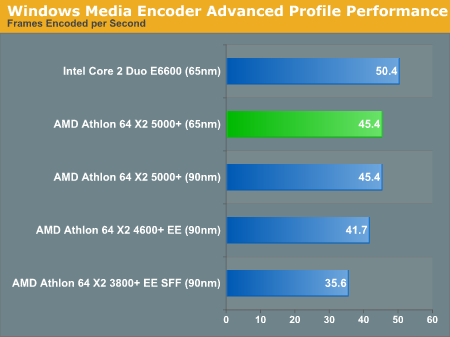
At the same price point, Intel is still faster with the E6600 as we've seen in the past, but what we're here mainly to do is to compare power usage, so let's see how Brisbane stacks up.

Power consumption is down from 90nm, as the 65nm system used about 15 fewer watts than its predecessor. The move to 65nm actually brings AMD in line with the power consumption of Intel's Core 2 Duo E6600, but it is still not enough to best the EE and EE SFF chips, the latter of which is rated at a cool 35W TDP.
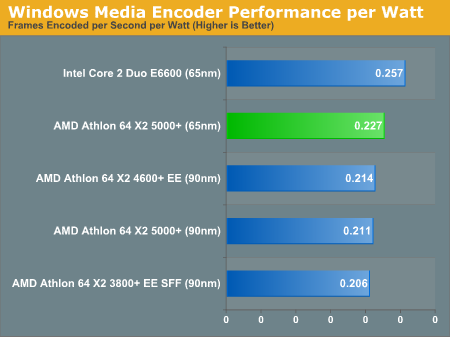
Performance per watt is a different story; although AMD can compete with Intel in terms of power usage, it will take a new architecture to close the performance gap and thus performance per watt suffers in comparison to Core 2 Duo. The good news is that if we just look at the AMD CPUs in the performance per watt chart, it looks like the new 65nm processor offers better performance per watt than anything else in AMD's lineup - even the EE/EE SFF CPUs.
Moving on to our DivX test we see more of the same: the performance lead clearly goes to Intel's Core 2 Duo E6600:
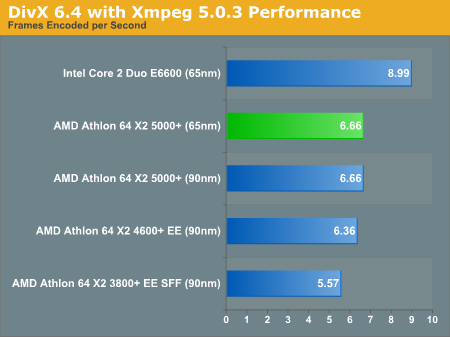
Power usage is actually slightly lower on the 65nm AMD system than on the Core 2 Duo platform, and a bit lower than the 90nm X2 5000+ setup. The difference between 90nm and 65nm isn't huge here, a matter of just under 10W, but hopefully it's merely a sign of an early 65nm process compared to a more mature 90nm process.
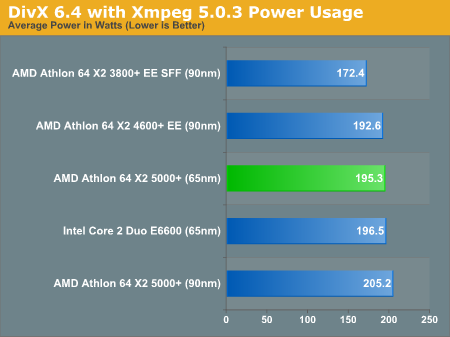
The performance per watt crown still belongs to Intel, but if you look at AMD alone, Brisbane offers better efficiency than anything else in AMD's lineup.
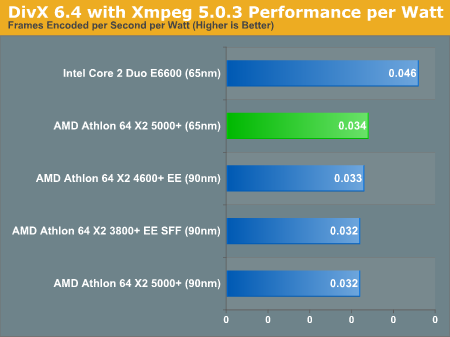










63 Comments
View All Comments
mino - Friday, December 15, 2006 - link
Read some paper on entropy.The problem in this discussion is most participants do not know what heat, electricity, work(i.e. in joule), work(i.e. inlogical one) means.
Except for electromagnetic waves that leak badly shielded PC and the energy required to transfer the information out of the PC (by monitor and network cables) the energy(in form of electricity) consumed by the CP is completely changed to heat.
In other words "focused" form of energy witch low entropy(electricity) is distributed to the environment and becomes an "unfocused" form of enegry, mostly heat. Also even the heat dispersed to the room is still partly focused in sense it still not spread to the whole universe.
Hope this clears it for some.
mino - Friday, December 15, 2006 - link
CP == PCsmitty3268 - Thursday, December 14, 2006 - link
I don't particularly know how transistors work (only the basics) but if a space heater isn't 100% efficient then why would a cpu be?Again, I could be wrong, but do you have any 3rd party info to support your claim?
Missing Ghost - Thursday, December 14, 2006 - link
I think space heaters are 100% efficient, except maybe if there is a fan, then it could be 99.999%.smitty3268 - Thursday, December 14, 2006 - link
If you can see something glowing, then at least part of the energy is producing visible light and not heat. Although now that you mention it, I think I heard that plain old light bulbs are fairly efficient heaters.smitty3268 - Thursday, December 14, 2006 - link
From http://www.intel.com/technology/silicon/si11031.ht...">http://www.intel.com/technology/silicon/si11031.ht...This implies what I was saying, but perhaps the devices only run cooler because they require less power to begin with?
JarredWalton - Thursday, December 14, 2006 - link
Heat density: less power in a smaller area can potentially run hotter (witness Prescott vs. Northwood P4). Except we're seeing the reverse here, so probably it's just a difference in chip/package design. There's no guarantee that the various chips are measured identically, meaning AMD could have changed temperature reporting with 65nm, and certainly the AMD vs. Intel numbers are not a direct comparison. I would put more weight on power numbers, personally.eRacer - Wednesday, December 20, 2006 - link
In future Brisbane reviews could you check the Brisbane idle temperature to see if it appears to be somewhat accurate? Other previews and leaks show Brisbane idle temperatures in the 10C-15C range which is well below room temperature. Idle and load temps of Brisbane may actually be 15C higher than what is reported.Stereodude - Thursday, December 14, 2006 - link
I was excluding the C2D from my comments. Sorry if that wasn't clear.If anything the die shrink should make the Brisbane run slightly hotter since the die is a little smaller. I can't come up with any good reason why one 65W processor runs cooler than another 65W processor given the same cooler and same size heat spreader. Maybe the heatspreaders aren't flat between all the AMD CPUs. The 35W AM2 processor definitely should have run cooler.
eRacer - Thursday, December 14, 2006 - link
"As you can expect, AMD is pricing the 65nm chips in line with its 90nm offerings to encourage the transition. Die size and TDP have both gone down to 147 mm^2 and 65W across the line.Is 147 mm^2 accurate? That happens to be the same die size of 90-nm A64 X2 Manchester, and isn't much of a shrink from the current 183mm^2 512KBx2 Windsor cores. Some rumors had put it at ~125 mm^2.